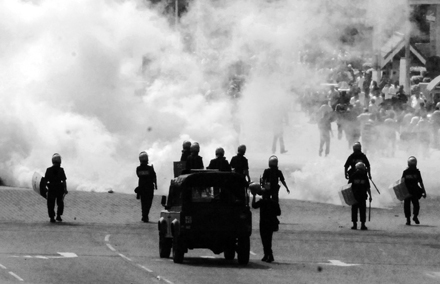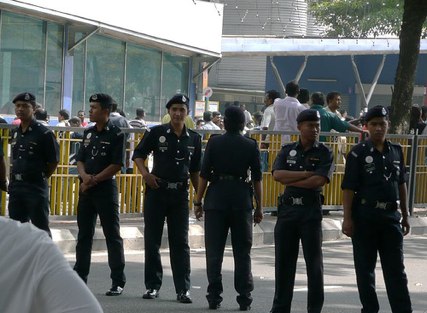Malaysian Indian activists made their way through traffic jams, blocked roads and closed train stations to rally in Kuala Lumpur on Sunday for equal rights in Malaysia.
Police in the city closed roads and two train stations near the British High Commission in anticipation of the rally organized by the Hindu Rights Action Force (HINDRAF). They used tear gas and water cannons laced with chemicals to disperse the crowds, effectively splitting the protest into different parts of the city. Protesters were dispersed along Jalang Ampang, near the Batu Caves (the site of a large Hindu temple) and near the Kuala Lumpur City Centre (KLCC), an area around the famed Petronas Towers. Protestors began gathering at KLCC as early as 7:30am and reports say that police were trying to disperse a crowd at the gates of the Batu Caves as late as 11:00pm.

Photo from Flickr user lastham [1]
Jelas.info blogger describes his first experience with tear gas [2] on Jalan Ampang:
I was near the front, and inexperienced with tear gas, so it caught me a little unawares. Oh by God it hurt.
I thought I was going to suffocate.
It was all I could do to walk slowly away with the fleeing crowd. I wasnít sure if thereíd be FRU beating us from behind as we left.
Because the crowds were so dispersed, estimates of how many protesters attended the rally varies. The BBC, which reported from outside the British High Commission [3] , said that more than 5,000 protesters rallied. The Associated Press (via The Telegraph in India) reported the crowd at over 10,000 [4]. Asia Times estimated that over 20,000 rallied [5], while the online news site Malaysiakini says 30,000 rallied.
The New Straits Times reports that 136 protesters now face charges. Three HINDRAF leaders were arrested on sedition charges on Friday before the protest, then released on Monday when the charges were dropped.
HINDRAF was denied a permit to march to the High Commission and submit a memo that calls on the British to pay US$4 trillion in reparations for bringing Indians to Malaysia as laborers before the country won its independence in 1967. Protesters said that Malaysia's laws are discriminatory to the country's large, mostly Tamil population. There are over 2 million Indians in Malaysia who are often denied business licenses, property and higher education due to quota systems which favor Malays, protesters said. Many in the crowd carried banners with images of Queen Elizabeth and Mahatma Gandhi.

Police near the British High Commission
But protesters also said that they were rallying to also get the attention of the Malaysian Indian Congress, whose president YB. Dato Seri S. Samy Vellu [6] has led the party since 1979. Many protesters expressed disappointment in the party's longtime inaction to help raise the status of Indians in Malaysia.
Colour Blind blogger Ronnie Liu said protesters were calling for Samy Vellu to step down [7]
MIC Leader S Samy Vellu must step down now. That seems to be the common sentiment of the 30,000 protesters today. Every single Indian brother and sister I met today wanted Samy to go. So Mr Samy Vellu, have you heard their voices?
Disquiet blogger and president of the National Human Rights Society Malik Imtiaz Sarwar compared the reaction by police to the HINDRAF protest to their reaction to a protest in June by UMNO Youth [8].
I do not necessarily agree with the manner in which HINDRAF has decided to espouse its cause. Though I recognize the point HINDRAF is making, I believe that we should be fighting for the cause of all underprivileged and marginalized Malaysians. Having said that, the apparently inconsistent stance of the Police and the Government where rallies are concerned can only lead one to a conclusion that there may be some truth to what HINDRAF is saying.
While many English-language bloggers and the international press, including AlJazeera [9] and the BBC [3], focused on police methods of dispersing the crowd, Malaysian newspapers The Star [10] and The New Straits Times [11] highlighted injured police officers and protesters’ violent behavior.